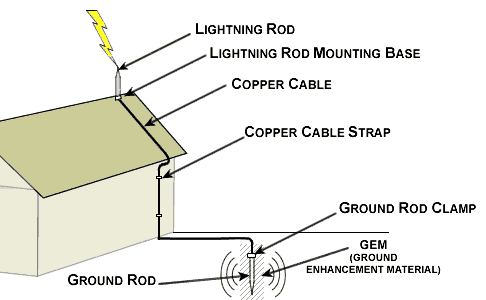The Lightning Menace and its tailor-made conductor
Dramatic!! That's how I would describe the lighting flash. Its great amount of heat, brightness and thunderous sound. Sorry, but there is nothing good about the lightning, it is a menacing disaster which comes as a huge spark of electric discharges and burns anything in its path, even your homes. This is why in every well-constructed building, there is a very long conductor that runs down from the roof beside the building to earth. This is known as a lightning conductor.
During rainy days, electrical charges in clouds build up, and strong electromagnetic fields are created causing unlike charges to attract each other. Steadily jumping from clouds to clouds or even to the earth down to your homes. Then lightning is formed. But the lightning conductor is available to annul its effect on the building. The conductor is designed to provide a safe path for the charges to the earth. It consists of sharp pointed metal rods or spikes attached to the highest point of the building and joined by a thick strip of a copper cable to a copper plate buried in the ground.
Why sharp rods and not cylindrical or any other shape?

Wikimedia
If we have a conductor in the shape of an egg with one end almost sharply pointed. And if it's charged by electrostatic induction, we can examine the charge distribution by using an electroscope. Such an examination will show that the charge density is highest at the sharper end as there would be the greatest deflection in the electroscope. As a result, when the conductor is placed in air, it causes the air around the sharp end to be ionized(breaking into positive and negative ions) leaving it either positively or negatively charged - usually positive of a lightning conductor. This is why the lightning would be drawn to the sharp end of the conductor and not any other part with a different shape.
Fun fact: The air around a lightning flash is about five times hotter than the sun's surface, approximately 50,000°F
Damn!! That's really hot! Why then doesn't the conductor melt?
Well, it is very thick and its copper, able to carry large currents without melting. And since this is a rare circumstance(the lightning strike on buildings), the conductor won't face continuous stress and strain.
This complete process is known as point action.
Sometimes the conductor neutralizes the thunderclouds before even forming a lightning strike. This happens because the sharp points gain induced charges opposite to those in the cloud. And by causing the air around to further ionize, a huge avalanche of positive ions forms and moves upward causing a positively charged space(cloud) in the atmosphere. This is what neutralizes all or part of the charge in the atmosphere and reduces the risk of lightning.
If however, lightning still strikes the building, the negatively charged electrons are attracted towards the spikes and are carried harmlessly down to the earth, through the conductor while the positive is repelled.
Cheers!!
.jpeg)
